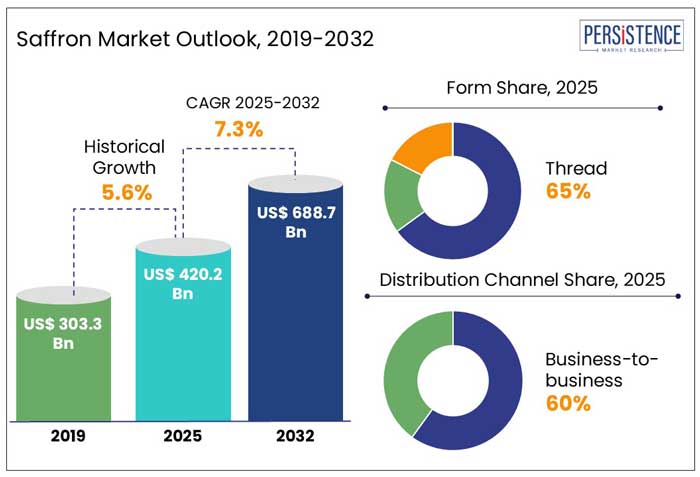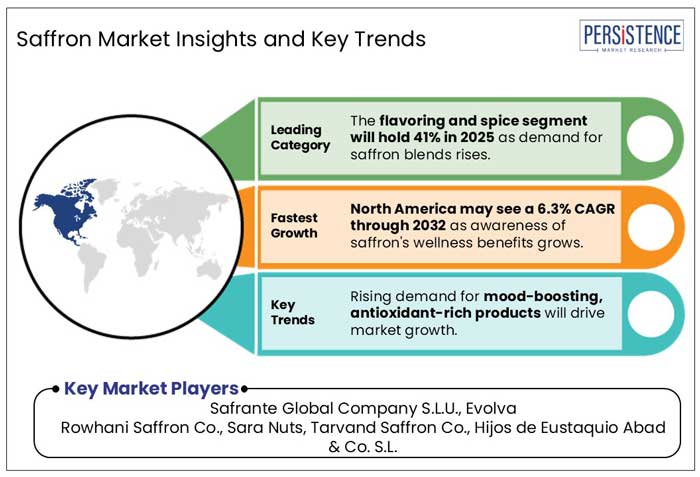ID: PMRREP33997| 182 Pages | 3 Feb 2025 | Format: PDF, Excel, PPT* | Food and Beverages

The global saffron market is estimated to reach a size of US$ 420.2 Mn in 2025. It is predicted to rise at a CAGR of 7.3% through the assessment period to attain a value of US$ 688.7 Mn by 2032.
Demand for saffron is envisioned to be fueled by its excellent antioxidant and health benefits, as well as its integral role in traditional cuisines like Indian, Spanish, and Persian dishes. Innovative product categories such as saffron-infused teas, oils, and cosmetics are seeing growth in the market due to cutting-edge technology that improves product quality and customer confidence.
Sales in the U.S. are projected to surge due to awareness of saffron's medicinal properties, like reducing anxiety and improving heart health. Domestic cultivation is gaining traction in states like Vermont and Pennsylvania, aiming to create a cost-effective supply chain. The ISO 3632 standards have strengthened consumer confidence, protecting against counterfeit products and fostering market growth.

Key Highlights of the Market
|
Market Attributes |
Key Insights |
|
Market Size (2025E) |
US$ 420.2 Mn |
|
Projected Market Value (2032F) |
US$ 688.7 Mn |
|
Global Market Growth Rate (CAGR 2025 to 2032) |
7.3% |
|
Historical Market Growth Rate (CAGR 2019 to 2023) |
5.6% |
North America is set to dominate the saffron industry, accounting for 32% of the global share in 2025. It is driven by increasing consumer awareness of saffron's culinary and wellness benefits. The market is projected to record a CAGR of 6.3% from 2025 to 2032.
The region's diverse food culture and high purchasing power have fueled demand for premium saffron in gourmet and organic products. The U.S. is leading this growth, with consumers seeking natural ingredients in food, cosmetics, and pharmaceuticals.
Brands like Saffron Road reported increased sales of saffron-infused ready-to-eat products in 2024. The pharmaceutical sector in North America is utilizing saffron's antioxidant and therapeutic properties in new formulations.
Asia Pacific is projected to attain a market share of 27% in 2025. The region is set to exhibit a CAGR of 7.8% from 2025 to 2032. This growth is driven by the region's rich culinary traditions, where saffron is a staple in cuisines such as Indian, Persian, and Middle Eastern.
Consumer awareness about saffron's health benefits, including its antioxidant properties and ability to improve mood and skin health, has fueled its demand in Asia Pacific. Countries like India and Iran, being leading producers, are leveraging favorable agricultural practices to boost production. Adoption of saffron in premium cosmetics and Ayurvedic formulations, as seen with brands like Forest Essentials, has broadened its applications in Asia Pacific.
The business-to-business (B2B) distribution channel is crucial in the trade of saffron worldwide. It is projected to hold a market share of 60% in 2025, due to its ability to handle bulk transactions efficiently.
Saffron producers rely on B2B platforms to connect with industries such as food and beverages, pharmaceuticals, and cosmetics, ensuring a steady supply chain and streamlined procurement. For instance,
To ensure industry-specific growth, business-to-business interactions in the processed food, nutraceuticals, and luxury sectors encourage market stability, customization, bulk discounts, and transparent trade agreements.
In 2025, saffron threads are projected to account for 65% of the global market share, driven by their authenticity and superior quality. Saffron threads, known for their unique flavor, vibrant hue, and aromatic essence, remain the top choice for chefs and home cooks globally.
In countries with a rich culinary legacy, saffron threads are widely sought after because of their exclusivity and laborious processing, which makes them useful in classic dishes like Persian sweets, Indian biryani, and Spanish paella. For instance,
Growing consumer knowledge of saffron's health benefits and its uses in cosmetics, personal care products, and high-end culinary items is driving the global saffron industry. Demand for saffron as a natural food coloring agent is rising in the food industry, while traditional medicine and Ayurvedic practices amplify its use in pharmaceuticals and nutraceuticals. High-end restaurants and gourmet food brands continue to incorporate saffron into luxury dishes. For example,
Climate change and the limited regions suitable for saffron cultivation impact supply, making authenticated, high-quality saffron increasingly sought after. For instance,
E-commerce platforms like Amazon and specialty retailers are improving the accessibility of saffron, while investments in modern cultivation techniques promise improved yield and reduced production costs.

The global saffron market recorded a CAGR of 5.6% in the historical period from 2019 to 2023. To extend their market share, key competitors focused on joint ventures, acquisitions, mergers, product launches, and strategic alliances during this period. For instance,
Demand for products featuring saffron is estimated to record a considerable CAGR of 7.3% during the forecast period between 2025 and 2032.
Rising Focus on Health and Wellness Trends
Health and wellness trends are driving the saffron market as consumers seek natural and beneficial products to incorporate into their diets. Saffron is well-known for its mood-boosting and antioxidant properties, making it a popular ingredient in teas, herbal supplements, and functional meals, among other health and wellness products. Its reputation as a natural remedy for specific ailments also contributes to the market's appeal.
Favorable conditions in countries such as Iran, India, and Spain ensure a steady supply of high-quality saffron. These countries play a vital role in maintaining and extending saffron production, especially as climate patterns and agricultural practices evolve.
High Demand for Natural Ingredients in the Food Industry
Since it is a premium substitute for artificial coloring and satisfies customers' desire for clean-label products, saffron, a natural food coloring agent, is becoming well-liked in the food industry. Companies are leveraging this shift to innovate and broaden their portfolios. For example,
The food industry's commitment to sustainability and authenticity is likely to boost saffron's demand across luxury desserts and premium beverages. This is anticipated to help in solidifying its position as a sought-after natural product.
Uncertainty of Climate and Presence of Fraudulent Products
In regions where the crop grows, such as Iran, Kashmir, and Afghanistan, where yields are being reduced by rising temperatures, erratic rainfall, and extreme weather events, climate change is creating an impact on the worldwide saffron industry.
Fraudulent saffron products and adulteration are threatening consumer trust. Companies like Novin Saffron and Krocus Kozanis are investing in innovative quality control technologies like DNA authentication and ISO 3632 certifications to ensure product authenticity. Transparent sourcing and verified quality are becoming industry standards as consumers demand genuine products.
Research and Development in Saffron Production
The goal of current research and modern farming methods is to increase saffron manufacturing and quality while reducing production expenses. For example,
Demand for natural skin care products is driving the use of saffron in cosmetics and personal care products, as its antioxidant-rich compound aids in skin rejuvenation in serums, creams, and face masks. In response to the rising desire for natural and clean cosmetic products, L'Oréal introduced its Saffron Glow line in 2023, highlighting the anti-aging and skin-brightening qualities of saffron.
Pharma and Nutraceutical Industries to Foster Growth Avenues
Saffron, a popular ingredient in traditional medicine and ayurvedic practices, is showcasing demand in the pharmaceutical and nutraceutical industries due to its therapeutic properties, including antioxidant, anti-inflammatory, and mood-enhancing effects. It is used in supplements and herbal remedies to improve mental health and immunity. For example,
Ayurvedic brands like Patanjali and Dabur are incorporating saffron into their product lines, including chyawanprash and herbal teas, promoting its use in wellness and holistic healing practices.
Manufacturers and suppliers of saffron are concentrating on providing premium products in eye-catching packaging. They are spending money on marketing campaigns and enlisting the help of celebrities to connect with their target market.
To increase their worldwide presence and revenues, they are also employing tactics like distribution agreements, partnerships, acquisitions, mergers, and advertising. To improve their market positions, they are taking part in alliances, product innovation, and regional growth.
Sustainability practices, authenticity, and product quality are a few of the factors that fuel the industry's competitiveness. Competition heats up as demand increases, which encourages continuous improvements and partnerships in the saffron industry.
Recent Industry Developments
By Form
By End Use
By Function
By Application
By Distribution Channel
By Region
The market size is set to reach US$ 688.7 Mn by 2032.
Iran is the world's largest producer of saffron, a costly spice, due to its extensive production volume.
In 2025, North America is set to attain a market share of 32%.
In 2025, the market is estimated to be valued at US$ 420.2 Mn.
Safrante Global Company S.L.U., Evolva, Rowhani Saffron Co, and Sara Nuts are a few key players.
|
Attributes |
Details |
|
Forecast Period |
2025 to 2032 |
|
Historical Data Available for |
2019 to 2023 |
|
Market Analysis |
US$ Million for Value |
|
Key Regions Covered |
|
|
Key Market Segments Covered |
|
|
Key Companies Profiled in the Report |
|
|
Report Coverage |
|
|
Customization and Pricing |
Available upon request |
Delivery Timelines
For more information on this report and its delivery timelines please get in touch with our sales team.
About Author